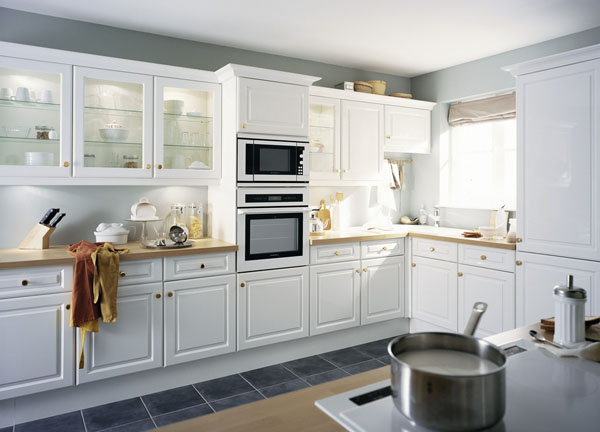Danish Firm Launches High-end U.S. Cabinetry Business Based on Ikea Cabinets
A Copenhagen, Denmark cabinetry design firm will soon begin producing kitchen projects for its soon-to-open Brooklyn, New York design operation. The business is based on engaging high-end architects to create kitchens using the Ikea cabinet lines as a basis.
A Copenhagen, Denmark cabinetry design firm will soon begin producing kitchen projects for its soon-to-open Brooklyn, New York design operation. The business is based on engaging high-end architects to create kitchens using the Ikea cabinet lines as a basis.

"We are looking to bring this concept to the U.S. because we received many requests," says Dorothee Van Mol, who heads up the Brooklyn, New York business of Reform. "We will manufacture our drawer fronts and doors and tabletops in the U.S. instead of shipping them from Denmark to the U.S."
Founded by Jeppe Christensen and Michael Andersen in 2014, Reform collaborates with top Danish and other internationally acclaimed architects to "reform kitchens" with great design, Van Mol says.
Christiansen holds a Masters in Marketing and Economics and is a former partner in a carpentry and design business. Andersen is an engineer and former employee at Bjarke Ingels' architectural firm BIG. Both say they noticed a growing interest around custom made carpentry kitchens, but also recognized pricing for such projects was far beyond the budgets of many people. To solve this problem they established Reform, designing unique kitchen fronts and countertops tops made from durable materials easy to combine with Ikeas basic and popular modules.
"The high end designs use the Ikea kitchen structure as a base, then 'dress up' the base with big brand designer and architect names and forward 'fashion' looks," says Van Mol, who has contracted with U.S. cabinetmakers to produce the projects.
Clients begun by ordering kitchen cabinets from Ikea, or they can begin with an Ikea kitchen already installed. Reform works with Metod and Faktum Ikea lines. After ordering (and projects are non-refundable), the client sends their Ikea order confirmation and work drawings along a choice of Reform kitchen and countertop style and color. Samples are available for a small fee. Reform sends an order confirmation, and delivers within 6 weeks once the project is accepted.
In addition to Ikea kitchen cabinets, Reform in Denmark also does customized fronts for the Ikea PAX wardrobe, Besta sideboard and Godmorgon bathroom furniture. The process is the same as with the kitchen, concerning the cabinets, the ordering and the mounting.
Drawer fronts and kitchen doors fit Ikea’s hinges and drawer slides. Kitchen and drawer fronts are made of 19 mm MDF and spray painted. A three-year warranty covers all fronts.
In addition to the Basis line, a kind of house standard, Reform offers BIG, Norm, and HLA lines from three architectural design firms.
Bjarke Ingels Group (BIG), a New York and Copenhagen architectural practice operating since 2005. (They worked on 2 World Trade Center in Manhattan.) Unusual touches in the BIG line include using seatbelt fabric for handles. BIG’s kitchen series is available for all the models and sizes offered by Ikea.
Drawer fronts and doors are available in two different materials: 19 mm white spray-painted MDF and 19 mm veneered oak. The handles are identical on both models and are made from the same black nylon used for seat belts. The handle is mounted by a black-painted fitting screwed on to the back of the door or the drawer front. (It can be placed for right or left opening.)
Bjarke and Ingels recommend for BIG a 10 mm worktop in black Getacore with a stainless sink welded to integrate with the worktop. Getacore is a mineral plate similar to Corian. For BIG, the plinth should be matte black (NCS S 9000-N gloss 20). The white painted version is matte white (NCS S 0500-N gloss 20).
The veneered front is European oak coated with clear wax.
The HLA Reform-kitchen created by Henning Larsen Architects is available in oak veneer with a band of copper, or spray painted white with a metal band to match. The color and surface of the untreated copper changes over time to develops its own character.
Fronts and doors have the same design: A 120 mm wide metal band along the side. Both fronts and doors have a thickness of 19 mm. The glued-on metal band is 0.8 mm.
HLA recommends a 19 mm countertop in oak veneer for its kitchens. Veneered oak is a 2 mm glued, wax-coated veneer. HLA suggests using cover panels in the same material as the surface of the drawer fronts and cabinet doors. The plinth look its best in the same material as the metal on the fronts – copper or stainless steel.
Another take on Ikea comes from Norm Architects, which has a practice in residential architecture and industrial interior design. Norm drawer fronts and doors are available in bronzed tombac (a brass alloy) glued on 198 mm black painted MDF, or in smoked oak and oak sawn veneer. All drawer fronts and cabinet doors have a 5x5 mm chamfer on the back. Edges are varnished and twice coated with wax. The bronzed tombac gradually gets a golden shine in the areas of continuous wear.
Norm fronts and doors in both oak sawn veneer and smoked oak are veneered on the front and back, and the same wood is used on the solid edges. The doors are wax-coated. Norm recommends a 19 mm countertop in fibre concrete, bronzed tombac, veneered, smoked or natural oak, and not necessarily in the same material as the drawer fronts and doors.

 沪公网安备31010402003309号
沪公网安备31010402003309号



